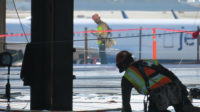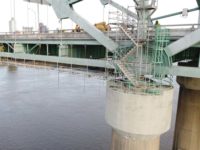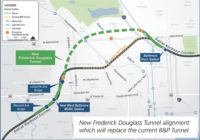
Interchanges at Interstate 495 (Top) and Route 123 (pictured here) add new connections between express lanes and general purpose lanes.
Photo courtesy of EMP
*Click on the photo for greater detail
With ramps, rubblization and double roundabouts, the Transform 66 project is living up to its name.
The 22.5-mile project entailing $2.3 billion in construction not only adds new toll lanes and connected-vehicle technology to the busy stretch of highway between the Capital Beltway and Gainesville, Va., but also makes new connections to park-and-ride facilities, new bicycle and pedestrian trails and room for potential transit within the highway in the future.
The project to improve the stretch of Interstate 66, called Outside the Beltway, is the result of the Virginia Dept. of Transportation’s first public-private partnership contract after it revised its P3 process to increase transparency and competitiveness.
“While having a consistent structure for our P3 initiatives with support at all levels of government has allowed Virginia’s P3 projects to succeed, our process has evolved over the years,” says Stephen C. Brich, VDOT commissioner. “To ensure the Commonwealth was in a position of strength in negotiations with the private sector, and to minimize risk and maximize benefits to the public, VDOT engaged in a competitive P3 procurement process for the Transform 66 Outside the Beltway project. The competitive P3 procurement included opportunities to discuss alternative technical concepts with bidders that could then be incorporated into the project, allowing VDOT access to the best ideas.”
Brich notes that the Transform 66 project is twice as large as VDOT’s previous P3 projects.
It is also a major piece of Northern Virginia’s planned 100-plus-mile express lanes network, of which 71 miles are built and 35 miles, including the 22.5 miles of Transform 66, are under construction. Westbound lanes between Interstate 495 and Route 28 opened this month, while nine miles of the westernmost section opened in September. All Outside the Beltway express lanes will be operational before year’s end, and high-occupancy lane requirements will increase to three passengers, from two.


The interchange at Route 28 (left) involved removing traffic signals to improve flow; the Nutley Street interchange included a double roundabout design.
Photos courtesy of EMP
*Click the images for greater detail
Thinking Outside the Beltway
I-66 Express Mobility Partners (EMP) won the 50-year concessionaire contract in 2016 to finance, design, build, maintain and operate two express lanes in each direction between the Capital Beltway (I-495) to Gainesville at U.S. Route 29. When complete, the expanded highway, which includes three general-purpose lanes in each direction, is expected to move 2,000 to 4,000 more people per hour along the corridor, which sees up to 200,000 daily vehicles.
The project also entails expanded transit service, park-and-ride lots, interchange enhancements and 11 miles of shared-use path connecting existing and planned trails.
“This is a good example of a long-term solution and benefits for those driving—and not driving,” says Nicolas Rubio, CEO Americas at Meridiam, which along with Cintra and APG comprises the EMP consortium, with a joint venture of Ferrovial Construction and Allan Myers (FAM Construction) as the design-build contractor. Rubio says the P3 approach saved $1 billion compared with traditional delivery, with an overall $3.7-billion investment into Virginia infrastructure during the course of the project.

The longest bridge structure on the job is 2,133 ft long, at the interchange with I-495.
VDOT solicited comments from the private and public sectors regarding whether to go forward with a P3, and evaluated design-build-finance-operate-maintain, design-build-operate-maintain and design-build using alternative technical concepts. In 2015, it issued Requests for Qualifications for all three models. Upon receiving conceptual financial proposals, VDOT selected DBFOM.
“I believe that the process followed by VDOT during the procurement stage, comparing different delivery methods and ultimately selecting a P3 as the one bringing the most value to the citizens of the Commonwealth, was unique, innovative and certainly very successful,” says Alberto Gonzalez, CEO of Cintra US.
“Our [P3] process has evolved over the years.”
Stephen C. Brich, VDOT Commissioner
Completing the procurement in 15 months took the precision of “a Swiss clock,” notes Luis Tejerina, CEO of EMP. VDOT also was completing federal environmental reviews and public review processes, notes Susan Shaw, VDOT megaprojects director. The two DBFOM teams were scored 70% on project cost and 30% on technical factors including public outreach and customer service.
EMP provided a $579-million upfront concession fee to the Commonwealth to fund additional improvement projects, $800 million to expand transit service and $350 million for additional projects over the next 50 years. “The median and the bridges are set up for future transit,” says Shaw, noting the participation of county authorities in identifying future needs.
While EMP bears risk for traffic and revenue, and for right-of-way acquisition, VDOT shares risk on condemned parcels. Heavy trucks will be allowed in express lanes, which will increase revenue for the concessionaire. The project also received a $1.2-billion TIFIA loan in 2017, which Tejerina believes is the “largest ever for this type of project.”

The 22.5-mile stretch of I-66 will feature three new express lanes in each direction and new connections to them.
*Click on the map for greater detail
Rubblization Meets the Road
Construction entails 18 miles of new shared-use trail along and near I-66 integrated with existing and planned trails, at least 4,000 new park-and-ride spaces, 12 interchanges rebuilt or modified, 63 new bridges, 2.2 million sq ft of new and replacement noise wall, 2.3 million sq ft of retaining wall, 2.5 million tons of asphalt and 21.99 million tons of steel rebar. Reserving a 42-ft-wide median for future transit meant “pushing everything to the outside,” says Pablo Molla, CEO of FAM Construction. Crews have been averaging $60 million per month worth of construction, with up to 2,000 workers on site at peak, he says.
FAM also used the latest techniques in rubblization, which is not common for the region. VDOT required that over 1 million sq yd of existing concrete pavement be replaced with asphalt. FAM conducted a series of trials to determine optimum energy conditions for rubblization equipment so that pavement sublayers are not damaged. Using mobile crushing operations along the project corridor, where the rubblized material was broken down into smaller granular pieces and reused, the team saved an estimated 21,500 truck trips, lowering the project’s carbon footprint. The need for subbase material from quarries was reduced by 166,000 cu yd, according to Ferrovial engineers.

The new express lanes and two general lanes in each direction must also accommodate a median for future transit.
Photos courtesy of EMP

Crews used sound waves to demolish the concrete, a first in Virginia, says Ivan Saer, FAM vice president of construction. “We adjusted the wave intensity to just go through the concrete and not [the sublayers].”
As with other major projects, labor and materials posed a big challenge. “We started designing bridges in pieces to begin work immediately,” Saer recalls. “In some areas, we could do the substructure and superstructure at the same time with one sub. But in most cases, we built foundations with one sub, then got the plans for the superstructure and brought in another sub.”
The pandemic caused delays with delivery of steel bridge beams, so the team sought fabricators throughout the Mid-Atlantic and the various partner firms brought in crews from as far as Texas, and self-performed when possible, Saer says.
Crews had to deal with utility relocations for stakeholders as diverse as the Washington Metropolitan Area Transit Authority (WMATA) and the FBI, notes Tejerina. One major goal: “Don’t touch WMATA,” as power lines and substations power an entire rail line.
In one case, a retaining wall had to be built atop an old pressurized sewer pipe, says Saer. “The water authority wanted no ground pressure at all.” The team considered a lightweight aggregate but ended up using a polyethylene foam, a robot and ultrasound waves to test the integrity of the pipe, and avoided its relocation.
“This is a good example of a long-term solution … for those driving—and not driving.”
Nicolas Rubio, CEO Americas, Meridiam
In other cases, the team worked closely with the Prince William County Service Authority on utility work. It installed 1,384 linear ft of 24-in. force main as deep as 12 ft and 300 linear ft of a 12-in. water line for the utility.
“We had initial discussions with FAM and ultimately entered a general agreement to define roles and responsibilities if any element of utility assets were in conflict with the work they proposed to do,” says Samer Beidas, director of engineering and planning for the authority. “They would coordinate with us to review their design and make sure the relocations met our standards and requirements. The agreement gave us an opportunity to request certain improvements and betterments to be completed by FAM related to our utility system as long as we paid for them.”
EMP also completed other projects that were originally not in its scope. The Route 28 interchange had been a separate VDOT project. “This project kicked off and that ended up getting pulled into our design,” says Bruce Barnett, design discipline lead at ATCS, which with joint venture partner Jacobs serves as the general engineering consultant to VDOT.
That interchange design was influenced by alternative technical concepts from FAM, he notes. “We changed some configurations such as lowering ramp elevations to be less impactful. One of the ideas was to eliminate four traffic signals to allow free flow. It really helped a lot during construction with improved maintenance of traffic.”
The interchange required 13 new bridges, notes Saer. “At the northeast quadrant we lowered the elevation around eight feet. There was hard rock, red shale. At one point we used [seven] hoe rams to remove rock.”
At Nutley Street, FAM proposed a double-roundabout interchange instead of VDOT’s diverging diamond concept. The design uses the existing bridge and is a first for Virginia. Other changes included building a four-lane bridge at Jermantown Road rather than a two-lane bridge, in response to the city of Fairfax, notes Barnett.
Of 63 new bridges, about 40 are steel girder bridges due to deflections and curves, while the rest are concrete-beam bridges, notes Barnett. The longest bridge structure is part of the interchange at I-495, at 2,133 ft in length. It included 22 foundations, three abutments, 17 spans and 160 steel girders, including the longest of the project, at 141.25 ft.

The alignment includes new asphalt pavement and recycling of rubblized concrete.
Photo courtesy of EMP

Investing in the Future
While the details are not finalized, “the idea is for [I-66] to be cutting-edge” in preparing for autonomous and connected vehicles, notes Barnett. “That was part of EMP’s proposal—they would advance that.”
According to Cintra, the I-66 project aims to serve as a blueprint for infrastructure supporting a mix of traffic through increased connectivity between vehicles and the road. Combined with high-powered cloud computing, Cintra’s system includes sensors for safety, image detection and weather response, antennas, highly reflective pavement markings, dynamic pricing, speed management, reflective surfaces and smart signage. Digital infrastructure includes enabling 5G and CV2X credential validation system connectivity, data capture and edge processing, high-definition mapping, GPS and positioning enhancements to enable in-vehicle services and safety.
The project has exceeded Disadvantaged Business Enterprise goals of $236 million or 15% committed—with $324 million or 20.62% committed, according to VDOT. The goal of on-the-job training for 24 people has been exceeded by at least three.
FAM is the first construction management and heavy construction company in northern Virginia to receive certification in the Virginia Values Veterans program, VDOT adds.






Post a comment to this article
Report Abusive Comment